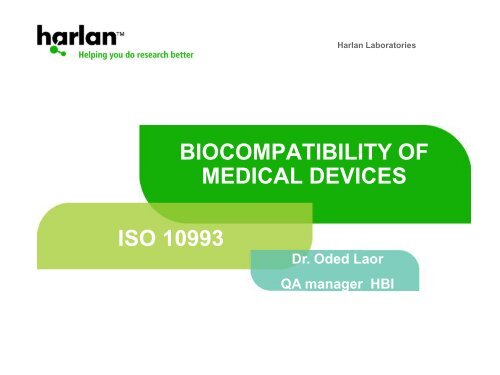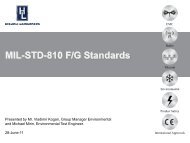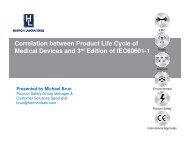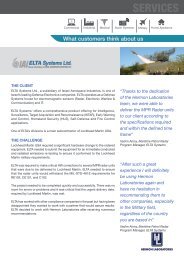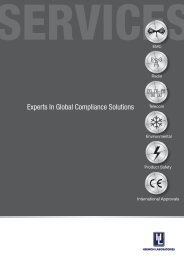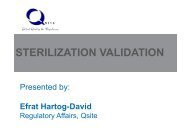biocompatibility of medical devices iso 10993 - Hermon Labs
biocompatibility of medical devices iso 10993 - Hermon Labs
biocompatibility of medical devices iso 10993 - Hermon Labs
You also want an ePaper? Increase the reach of your titles
YUMPU automatically turns print PDFs into web optimized ePapers that Google loves.
Harlan Laboratories<br />
BIOCOMPATIBILITY OF<br />
MEDICAL DEVICES<br />
ISO <strong>10993</strong><br />
Dr. Oded Laor<br />
QA manager HBI
WHAT IS MEDICAL DEVICE?<br />
Any instrument, apparatus, implement, machine, appliance, implant,<br />
in vitro reagent or calibrator, s<strong>of</strong>tware, material or other similar or<br />
related article, intended by the manufacturer to be used, alone or in<br />
combination, for human beings for one or more <strong>of</strong> the specific<br />
purpose (s) <strong>of</strong>:<br />
diagnosis, prevention, monitoring, treatment or alleviation <strong>of</strong> disease<br />
or an injury, investigation, replacement, modification, or support <strong>of</strong><br />
the anatomy or <strong>of</strong> a physiological process, supporting or sustaining<br />
life, disinfection <strong>of</strong> <strong>medical</strong> <strong>devices</strong>, and which<br />
does not achieve its primary intended action in or on the human<br />
body by pharmacological, immunological or metabolic means,<br />
but may be assisted in its function by such means<br />
Harlan Laboratories 2
DEFINITION<br />
Biological evaluation <strong>of</strong> <strong>medical</strong> <strong>devices</strong> is performed to<br />
determine the potential toxicity resulting from contact <strong>of</strong><br />
the device with the body.<br />
‣ Do not produce adverse mechanical and/or biological,<br />
local or systemic effects<br />
‣ Leachable or degradation products are not<br />
carcinogenic<br />
‣ No adverse effect on biological systems (reproductive,<br />
immune, nerve etc.) and/or developmental effects<br />
Harlan Laboratories 3
BLUE BOOK MEMORANDUM (G95-1) May1, 1995<br />
Harlan Laboratories 4
INTERNATIONAL STANDARDS<br />
ISO <strong>10993</strong><br />
Biological evaluation <strong>of</strong> <strong>medical</strong> <strong>devices</strong><br />
ISO 14971<br />
Medical <strong>devices</strong> -Application <strong>of</strong> risk management to<br />
<strong>medical</strong> <strong>devices</strong><br />
Harlan Laboratories 5
ASTM / ASTM International<br />
NATIONAL STANDARDS<br />
American Society for Testing and Materials<br />
ANSI<br />
American National Standards Institute<br />
AAMI<br />
American National Standards Institute<br />
BSI<br />
British Standards<br />
DIN<br />
German Institute for Standardization<br />
A joint effort by standards development organizations AAMI, ANSI, ASTM, and<br />
DIN created a single, centralized database for <strong>medical</strong> device standards.<br />
Harlan Laboratories 6
ISO <strong>10993</strong> GUIDELINE<br />
The ISO <strong>10993</strong> Guideline covers only the<br />
testing <strong>of</strong> materials and <strong>devices</strong> that come<br />
into direct or indirect contact with the<br />
patient's body<br />
With the exception <strong>of</strong> Products which might be considered to be<br />
<strong>medical</strong> <strong>devices</strong> but for which there is not yet a harmonized approach,<br />
are:<br />
1. aids for disabled/handicapped people;<br />
2. <strong>devices</strong> for the treatment/diagnosis <strong>of</strong> diseases and injuries in animals;<br />
3. accessories for <strong>medical</strong> <strong>devices</strong>;<br />
4. <strong>devices</strong> incorporating animal and human tissues, which might meet<br />
the requirements <strong>of</strong> the above definition but are subject to different<br />
controls.<br />
Harlan Laboratories 7
ISO <strong>10993</strong> GUIDELINE<br />
Biological Evaluation <strong>of</strong> Medical Devices<br />
Part 1: Evaluation and testing within a risk management process<br />
Part 2: Animal welfare requirements<br />
Part 3: Tests for genotoxicity, carcinogenicity and reproductive toxicity<br />
Part 4: Selection <strong>of</strong> tests for interactions with blood<br />
Part 5: Tests for in vitro cytotoxicity<br />
Part 6: Tests for local effects after implantation<br />
Part 7: Ethylene oxide sterilization residuals<br />
Part 9: Framework for identification and quantification <strong>of</strong> potential degradation products<br />
Part 10: Tests for irritation and skin sensitization<br />
Part 11: Tests for systemic toxicity<br />
Part 12: Sample preparation and reference materials<br />
Part 13: Identification and quantification <strong>of</strong> degradation products from polymeric <strong>medical</strong> <strong>devices</strong><br />
Part 14: Identification and quantification <strong>of</strong> degradation products from ceramics<br />
Part 15: Identification and quantification <strong>of</strong> degradation products from metals and alloys<br />
Part 16: Toxicokinetic study design for degradation products and leachables<br />
Part 17: Establishment <strong>of</strong> allowable limits for leachable substances<br />
Part 18: Chemical characterization <strong>of</strong> materials<br />
Part 19: Physico-chemical, morphological and topographical characterization <strong>of</strong> materials<br />
Part 20: Principles and methods for immunotoxicology testing <strong>of</strong> <strong>medical</strong> <strong>devices</strong><br />
Harlan Laboratories 8
IMPORTANT<br />
This part <strong>of</strong> ISO <strong>10993</strong> is intended for use by pr<strong>of</strong>essionals,<br />
appropriately qualified by training and experience, who are<br />
able to interpret its requirements and judge<br />
the outcome <strong>of</strong> the evaluation for each<br />
<strong>medical</strong> device, taking into consideration<br />
all the factors relevant to the device,<br />
its intended use and the current knowledge<br />
<strong>of</strong> the <strong>medical</strong> device provided by review<br />
<strong>of</strong> the scientific literature and previous<br />
clinical experience.<br />
Harlan Laboratories 9
BIOLOGICAL EVALUATION OF MEDICAL<br />
DEVICES<br />
Assessment <strong>of</strong> the biological safety <strong>of</strong> the <strong>medical</strong> device<br />
starts with:<br />
Evaluation <strong>of</strong> existing relevant data from all sources<br />
Any history <strong>of</strong> clinical use or<br />
human exposure data<br />
Any existing toxicology and<br />
other biological safety data<br />
on product and component<br />
materials, breakdown products<br />
and metabolites<br />
Identification <strong>of</strong> gaps in the<br />
available data set on the<br />
basis <strong>of</strong> a risk analysis<br />
Harlan Laboratories 10
BIOLOGICAL EVALUATION OF MEDICAL<br />
DEVICES<br />
Identification <strong>of</strong> additional data<br />
necessary to analyze the biological<br />
safety <strong>of</strong> the device<br />
The physical and chemical<br />
characteristics <strong>of</strong> the various<br />
candidate materials<br />
In assessing the relevance <strong>of</strong><br />
data, on prior use <strong>of</strong> a material,<br />
to the biological evaluation,<br />
the level <strong>of</strong> confidence in<br />
the historical data should be<br />
taken into account<br />
Harlan Laboratories 11
MATERIAL CHARACTERIZATION<br />
Material characterization is a<br />
crucial first step in the<br />
biological evaluation process.<br />
In the selection <strong>of</strong> materials to be used in device<br />
manufacture, the first consideration shall be<br />
fitness for purpose with regard to<br />
characteristics and properties <strong>of</strong> the<br />
material, which include chemical,<br />
toxicological, physical, electrical,<br />
morphological and mechanical<br />
properties<br />
Harlan Laboratories 12
MATERIAL CHARACTERIZATION<br />
The extent <strong>of</strong> required chemical characterization depends<br />
on what pre-clinical and clinical safety and toxicological<br />
data exist, and on the nature and duration <strong>of</strong> body<br />
contact with the <strong>medical</strong> device<br />
but as a minimum<br />
The characterization shall address the constituent<br />
chemicals <strong>of</strong> the device and possible residual process<br />
aids or additives used in its manufacture<br />
Harlan Laboratories 13
MATERIAL CHARACTERIZATION<br />
The identity and quantity <strong>of</strong> novel materials and<br />
chemicals present should be established or measured<br />
For <strong>devices</strong> that have known leachable chemical<br />
mixtures, potential synergies <strong>of</strong> the leachable<br />
chemicals should be considered<br />
Where the potential for degradation<br />
exists under the conditions <strong>of</strong><br />
manufacture, sterilization, transport,<br />
storage, and use <strong>of</strong> the device, the<br />
presence and nature <strong>of</strong> degradation<br />
products shall be characterized<br />
Harlan Laboratories 14
BIOLOGICAL EVALUATION TESTS<br />
Testing shall be performed on<br />
the sterile final product, or<br />
representative samples from the<br />
final product or materials<br />
processed in the same manner<br />
as the final product (including<br />
sterilization).<br />
Harlan Laboratories 15
SELECTION OF A REPRESENTATIVE SAMPLE<br />
If a device cannot be tested as a whole, each individual material in the final<br />
product shall be represented proportionally in the test sample.<br />
The test sample <strong>of</strong> <strong>devices</strong> with surface coatings shall include both<br />
coating material and the substrate, even if the substrate has no tissue<br />
contact.<br />
The test sample shall include a representative portion <strong>of</strong> the joint and/or<br />
seal if adhesives, radio frequency (RF) seals, or solvent seals are used in<br />
the manufacture <strong>of</strong> a portion <strong>of</strong> the device which contacts patients.<br />
When different materials are present in a single device, the potential for<br />
synergies and interactions shall be considered in the choice <strong>of</strong> test<br />
sample.<br />
The test sample shall be chosen to maximize the exposure <strong>of</strong><br />
the test system to the components <strong>of</strong> a device that are known<br />
to have potential for a biological response.<br />
Harlan Laboratories 16
EXTRACT PREPARATION<br />
The extraction vehicles and conditions <strong>of</strong> extraction used shall<br />
be appropriate to the nature and use <strong>of</strong> the final product and to<br />
the purpose <strong>of</strong> the test<br />
a) (37 ± 1) °C for (72 ± 2) h;<br />
b) (50 ± 2) °C for (72 ± 2) h;<br />
c) (70 ± 2) °C for (24 ± 2) h;<br />
d) (121 ± 2) °C for (1 ± 0,1) h.<br />
The increased temperature may cause cross-linking and/or<br />
polymerization <strong>of</strong> the polymer and, therefore, decrease the amount <strong>of</strong><br />
free monomer that is available to migrate from the polymer<br />
<br />
The increased temperature could cause degradation products to form<br />
that are not typically found in the finished device under conditions <strong>of</strong><br />
use<br />
Harlan Laboratories 17
SAMPLE SIZE<br />
Area includes the combined area <strong>of</strong> both sides <strong>of</strong> the sample<br />
Harlan Laboratories 18
BIOLOGICAL EVALUATION TESTS<br />
All tests shall be conducted<br />
according to recognized<br />
current/valid best<br />
laboratory/quality practices,<br />
for example<br />
Good Laboratory Practice (GLP)<br />
or ISO/IEC 17025<br />
and the data shall be<br />
evaluated by competent,<br />
informed pr<strong>of</strong>essionals.<br />
Harlan Laboratories 19
Harlan Laboratories<br />
GLP implementation<br />
Non-Clinical Studies<br />
Biocompatibility<br />
studies<br />
MEDICAL DEVICE
QUALITY SYSTEMS<br />
General<br />
Quality systems intended to assure<br />
production <strong>of</strong> quality products<br />
“suitable for the customer”<br />
Good Laboratory Practice<br />
Specific Quality System imposed by<br />
the authorities when public health<br />
is involved<br />
Non-clinical safety studies<br />
Harlan Laboratories 21
OECD Principles <strong>of</strong> GLP<br />
MAIN GLP GUIDELINES<br />
No 1: OECD Principals on Good Laboratory Practice<br />
FDA CFR Code <strong>of</strong> Federal Regulations Title 21<br />
PART 58 Good Laboratory Practice for Non-clinical<br />
Laboratory Studies<br />
EPA US Environmental Protection Agency<br />
Good Laboratory Practices Standards<br />
40 CFR part 160 FIFRA Federal Insecticide, Fungicide, and<br />
Rodenticide Act<br />
40 CFR part 792 TSCA Toxic Substances Control Act<br />
Harlan Laboratories 22
Areas <strong>of</strong> Expertise<br />
OECD – GLP<br />
1. Physical-chemical testing<br />
2. Toxicity studies<br />
3. Mutagenicity studies<br />
4. Environmental toxicity studies on aquatic and terrestrial organisms<br />
5. Studies on behavior in water, soil and air;<br />
Bioaccumulation<br />
6. Residue studies<br />
7. Studies on effects on mesocosms and natural ecosystems<br />
8. Analytical and clinical chemistry testing<br />
9. Other studies<br />
Harlan Laboratories 23
OECD DEFINITIONS<br />
The purpose <strong>of</strong> the Principles <strong>of</strong> Good<br />
Laboratory Practice is to promote the<br />
development <strong>of</strong> quality test data.<br />
The Principles <strong>of</strong> GLP should be applied to<br />
the non-clinical safety testing <strong>of</strong> test<br />
items contained in pharmaceutical<br />
products, pesticide products, cosmetic products, veterinary<br />
drugs, food additives, feed additives, and industrial chemicals.<br />
The purpose <strong>of</strong> testing these test items is to obtain data on their<br />
properties and/or their safety with respect to human health and/or<br />
The environment.<br />
Harlan Laboratories 24
Good Laboratory Practice (GLP) is a quality system<br />
concerned with the organizational process and the<br />
conditions under which non-clinical health and<br />
environmental safety studies are:<br />
Planned<br />
Performed<br />
SCOPE<br />
Monitored<br />
Recorded<br />
Reported<br />
Archived<br />
Harlan Laboratories 25
MILESONES<br />
RESOURCES<br />
Manpower ; Facility ; equipment<br />
REGULATIONS<br />
Standard Operating Procedures<br />
CHARACTERIZATION<br />
Test materials ; Reference materials<br />
DOCUMENTATION<br />
On-line recording ; Final Report ; Archiving<br />
CONTROL SYSTEM<br />
Quality Assurance Department<br />
Harlan Laboratories 26
RESOURCES<br />
Management commitment<br />
Each test facility management should ensure that these<br />
Principles <strong>of</strong> Good Laboratory Practice are complied with, in its<br />
testing facility<br />
Appointment <strong>of</strong> Study Director<br />
Ensure that a sufficient number <strong>of</strong> qualified and trained<br />
personnel, appropriate facilities, equipment, and materials are<br />
available for the timely and proper conduct <strong>of</strong> the study<br />
Harlan Laboratories 27
STANDARD OPERATING PROCEDURES<br />
A test facility should have written Standard<br />
Operating Procedures approved by Test Facility<br />
Management and Quality Assurance that are<br />
intended to ensure the quality and integrity <strong>of</strong> the<br />
data generated by that test facility<br />
Deviations from Standard Operating Procedures<br />
related to the study should be documented<br />
Harlan Laboratories 28
CHARACTERIZATION<br />
Test Item/Test Device is any product that has to be evaluated<br />
and is the reason for the conduct <strong>of</strong> the Study<br />
Each Test and Reference Items should be appropriately identified<br />
‣Mean <strong>of</strong> Identification / composition / purity<br />
‣Expiry date<br />
‣Storage conditions<br />
‣Safety data<br />
‣Disposal<br />
Harlan Laboratories 29
DOCUMENTATION<br />
For each study, a written Study Plan should exist prior to<br />
the initiation <strong>of</strong> the study<br />
All data generated during the study should be recorded<br />
directly, promptly, accurately and legibly<br />
A Final Report should be issued for each Study<br />
Storage (Archiving)<br />
Study plan, raw data, samples & specimens, and the final report<br />
<strong>of</strong> each study<br />
All QA inspections performed by the Quality Assurance<br />
Programme<br />
Records <strong>of</strong> qualifications, training, experience and job<br />
descriptions <strong>of</strong> personnel<br />
Records and reports <strong>of</strong> the maintenance and calibration <strong>of</strong><br />
apparatus<br />
Harlan Laboratories 30
CONTROL SYSTEM<br />
The testing facility should have a documented Quality<br />
Assurance Programme to assure that studies<br />
performed are in compliance with the Principles <strong>of</strong><br />
Good Laboratory Practice.<br />
Verify that the Study Plan and Study Report contains the<br />
information required for compliance with the Principles <strong>of</strong><br />
Good Laboratory Practice and Regulatory Requirements<br />
Conduct inspections to assure that the studies are comply<br />
with the Principles <strong>of</strong> Good Laboratory Practice and<br />
conducted according to the Study Plan & Standard<br />
Operating Procedure<br />
Harlan Laboratories 31
CHECKLIST<br />
1. GLP accreditation<br />
2. Management commitment<br />
3. Qualified Personnel – Training Records<br />
4. Quality Assurance Department<br />
5. Adequate Facility<br />
6. Availability <strong>of</strong> Calibrated equipment<br />
7. Controlled and certified reagents<br />
8. known and controlled source <strong>of</strong> Test System (in-vivo / in-vitro)<br />
9. Formulation Department<br />
10. Archiving<br />
Harlan Laboratories 32
USE ONLY CERTIFIED LABORATORY<br />
GLP like<br />
Based on GLP<br />
According to GLP<br />
In the spirit <strong>of</strong> GLP<br />
Etc……<br />
Harlan Laboratories 33
Thank you<br />
Oded laor<br />
Harlan Laboratories 34


